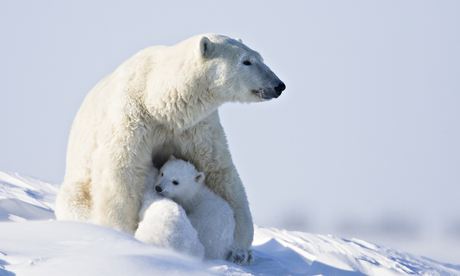Fewer polar bear cubs are
being born in the Arctic
islands, survey finds
Rapid reduction of sea ice level due to climate change hitting population as hunting ground recedes

A polar bear nurses her two cubs. Global warming is reducing the sea ice level that female polar cubs need to hunt for food. Photograph: Frank Lukasseckfrank Lukasseck/Getty Images
The proportion of polar bear
females around the Arctic islands
of Svalbard who gave birth to cubs
crashed to just 10% in 2014, according
to a small scientific survey of the animals.
It follows a series of warm years and poor
sea ice.
females around the Arctic islands
of Svalbard who gave birth to cubs
crashed to just 10% in 2014, according
to a small scientific survey of the animals.
It follows a series of warm years and poor
sea ice.
The Barents Sea population of a few
thousand polar bears is one of the
biggest in the world. But global warming
is rapidly reducing the extent of sea ice
on which the bears hunt seals, their main
food.
thousand polar bears is one of the
biggest in the world. But global warming
is rapidly reducing the extent of sea ice
on which the bears hunt seals, their main
food.
The annual survey undertaken by Jon
Aars and his colleagues at the
Norwegian Polar Institute was conducted
in April, just after cubs and mothers leave
their dens. They discovered that just three
of the 29 adult females they tracked and
examined had a cub born that year.
Aars and his colleagues at the
Norwegian Polar Institute was conducted
in April, just after cubs and mothers leave
their dens. They discovered that just three
of the 29 adult females they tracked and
examined had a cub born that year.
"This is a lower number than we would have
expected," he told the Guardian. "Typically
one third or more of the adult females have
cubs from that year." But even this higher
level is in long-term decline: annual records
dating back two decades show that about half
of adult females in Svalbard had cubs in the
mid-1990s.
expected," he told the Guardian. "Typically
one third or more of the adult females have
cubs from that year." But even this higher
level is in long-term decline: annual records
dating back two decades show that about half
of adult females in Svalbard had cubs in the
mid-1990s.
"Maybe this [year's low number] was because
we have had mild years recently with worse
ice conditions or maybe it was just a bad
year," said
Aars, who says it is too early to conclude
the population is collapsing. "It is alarming
but it is
quite a small sample, so we have to be
careful.
But if this is something that repeats itself in
coming years then it will be a concern."
we have had mild years recently with worse
ice conditions or maybe it was just a bad
year," said
Aars, who says it is too early to conclude
the population is collapsing. "It is alarming
but it is
quite a small sample, so we have to be
careful.
But if this is something that repeats itself in
coming years then it will be a concern."
Like a number of polar populations in remote
regions, scientists do not have enough data
to say whether Barents Sea polar bear
numbers are rising or falling. Aars is confident
that numbers bounced back after mass killing
of polar bears by hunters was outlawed on
Svalbard in 1973, and lie somewhere
between 1900 and 3600.
regions, scientists do not have enough data
to say whether Barents Sea polar bear
numbers are rising or falling. Aars is confident
that numbers bounced back after mass killing
of polar bears by hunters was outlawed on
Svalbard in 1973, and lie somewhere
between 1900 and 3600.
"They were nearly hunted to extinction,"
he said. "But we are pretty sure there are
more bears now than in 1973, probably
about twice as many."
he said. "But we are pretty sure there are
more bears now than in 1973, probably
about twice as many."
As to the future, he said: "With worse and
worse sea ice conditions we think there
will come a point when the population will
suffer, but we don't know when that point is."
worse sea ice conditions we think there
will come a point when the population will
suffer, but we don't know when that point is."
Winter ice cover in the Arctic fell to its fifth
lowest extent on record in 2014. This
continues a long-term trend of decline
which is occurring more rapidly than
scientists expected and the ice cap
could vanish in summer within decades.
lowest extent on record in 2014. This
continues a long-term trend of decline
which is occurring more rapidly than
scientists expected and the ice cap
could vanish in summer within decades.










No comments:
Post a Comment